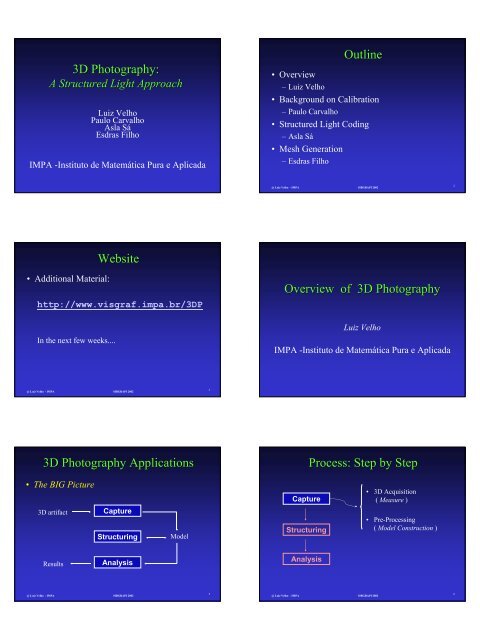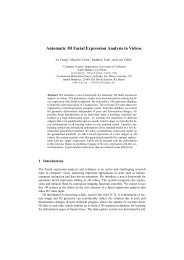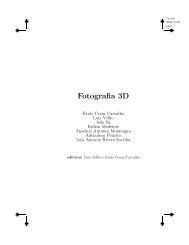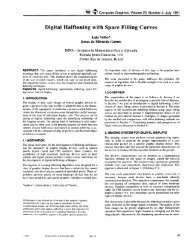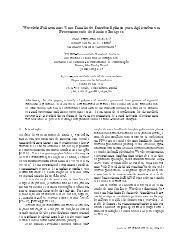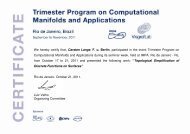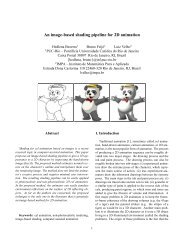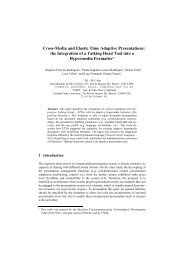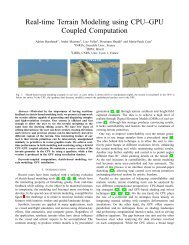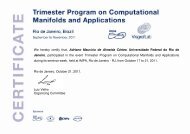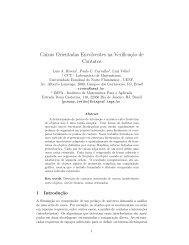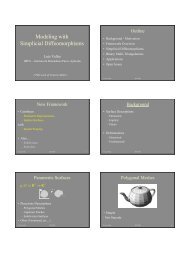3D Photography: Outline Website Overview of 3D ... - Visgraf - Impa
3D Photography: Outline Website Overview of 3D ... - Visgraf - Impa
3D Photography: Outline Website Overview of 3D ... - Visgraf - Impa
You also want an ePaper? Increase the reach of your titles
YUMPU automatically turns print PDFs into web optimized ePapers that Google loves.
<strong>3D</strong> <strong>Photography</strong>:<br />
A Structured Light Approach<br />
Luiz Velho<br />
Paulo Carvalho<br />
Asla Sá<br />
Esdras Filho<br />
IMPA -Instituto de Matemática Pura e Aplicada<br />
<strong>Outline</strong><br />
• <strong>Overview</strong><br />
–Luiz Velho<br />
• Background on Calibration<br />
– Paulo Carvalho<br />
• Structured Light Coding<br />
–AslaSá<br />
• Mesh Generation<br />
–EsdrasFilho<br />
@ Luiz Velho - IMPA SIBGRAPI 2002<br />
2<br />
<strong>Website</strong><br />
• Additional Material:<br />
http://www.visgraf.impa.br/<strong>3D</strong>P<br />
In the next few weeks....<br />
<strong>Overview</strong> <strong>of</strong> <strong>3D</strong> <strong>Photography</strong><br />
Luiz Velho<br />
IMPA -Instituto de Matemática Pura e Aplicada<br />
@ Luiz Velho - IMPA SIBGRAPI 2002<br />
3<br />
<strong>3D</strong> <strong>Photography</strong> Applications<br />
Process: Step by Step<br />
• The BIG Picture<br />
<strong>3D</strong> artifact Capture<br />
Structuring<br />
Model<br />
Capture<br />
Structuring<br />
• <strong>3D</strong> Acquisition<br />
( Measure )<br />
• Pre-Processing<br />
( Model Construction )<br />
Results<br />
Analysis<br />
Analysis<br />
@ Luiz Velho - IMPA SIBGRAPI 2002<br />
5<br />
@ Luiz Velho - IMPA SIBGRAPI 2002<br />
6
@ Luiz Velho - IMPA SIBGRAPI 2002<br />
Process: Step by Step<br />
Process: Step by Step<br />
Capture<br />
Structuring<br />
• Integration<br />
( Intra-Model )<br />
• Classification<br />
( Database )<br />
Capture<br />
Structuring • Simulations<br />
( Computation )<br />
Analysis<br />
Analysis<br />
• Display<br />
( Visualization )<br />
7<br />
@ Luiz Velho - IMPA SIBGRAPI 2002<br />
8<br />
Characteristics <strong>of</strong> the Process<br />
Potential Applications<br />
• Process can be Interactive (feedback)<br />
<strong>3D</strong> artifact<br />
Results<br />
Capture<br />
Structuring<br />
Analysis<br />
Model<br />
• Science and History<br />
– Digital Record<br />
– Global Controlled Archive<br />
– Computation and Simulation<br />
• Culture and Education<br />
– Virtual Exhibitions<br />
– Interactive Content<br />
– Physical Replicas<br />
* Usually Application Dependent<br />
@ Luiz Velho - IMPA SIBGRAPI 2002<br />
9<br />
@ Luiz Velho - IMPA SIBGRAPI 2002<br />
10<br />
Traditional Pipeline<br />
•Capture<br />
– Calibration - Fundamentals (Paulo Cezar)<br />
– Active Stereo - CSL coding (Asla)<br />
• Structuring<br />
– Scan Alignment - ICP<br />
– Surface Meshing - Ball Pivoting (Esdras)<br />
• Analysis<br />
– Property Estimation<br />
– Visualization<br />
Recovering depth from images:<br />
triangulation and calibration<br />
Paulo Cezar P. Carvalho<br />
IMPA -Instituto de Matemática Pura e Aplicada<br />
@ Luiz Velho - IMPA SIBGRAPI 2002<br />
11
@ Luiz Velho - IMPA SIBGRAPI 2002<br />
Recovering depth from images<br />
• Basic principle: stereo vision<br />
– same object point in two different views<br />
– object point recovered by intersecting viewing rays<br />
(triangulation)<br />
Passive stereo<br />
• Uses two (or more) images<br />
• Problem: it is difficult to match points across views<br />
–Noise<br />
– Innacurate depth estimation<br />
13<br />
@ Luiz Velho - IMPA SIBGRAPI 2002<br />
14<br />
Active stereo<br />
Laser Scanners<br />
• Replace one <strong>of</strong> the cameras by an easy-todetect<br />
light source directed at the image<br />
‣Laser scanners<br />
‣Structured light coding<br />
(figure by M. Levoy)<br />
@ Luiz Velho - IMPA SIBGRAPI 2002<br />
15<br />
@ Luiz Velho - IMPA SIBGRAPI 2002<br />
16<br />
Laser Scanners<br />
Structured Light<br />
•Pros<br />
– Very accurate<br />
• Cons<br />
– Slow (a beam at a time)<br />
–Expensive<br />
– Size limitation<br />
• Replace laser beam by projected pattern<br />
@ Luiz Velho - IMPA SIBGRAPI 2002<br />
17<br />
@ Luiz Velho - IMPA SIBGRAPI 2002<br />
18
@ Luiz Velho - IMPA SIBGRAPI 2002<br />
Recovering Depth<br />
Recovering Depth<br />
known plane<br />
reconstructed point<br />
P<br />
image point<br />
camera optical<br />
center<br />
• Depth computation: intersect viewing ray<br />
corresponding to the pixel with pattern<br />
projecting plane<br />
• It requires knowing position and orientation <strong>of</strong><br />
both camera and projector in the same frame <strong>of</strong><br />
reference.<br />
‣(joint) calibration<br />
19<br />
@ Luiz Velho - IMPA SIBGRAPI 2002<br />
20<br />
Camera Calibration<br />
• Goal: to recover the camera parameters<br />
M = (x,y, z)<br />
x<br />
z<br />
Y’<br />
m<br />
y<br />
X’<br />
Z<br />
Y<br />
X<br />
v<br />
(u,v)<br />
u<br />
Camera Calibration<br />
• Simple camera model<br />
(no lens distortion, no angular deformation)<br />
⎡x⎤<br />
⎡u<br />
⎤ ⎡α<br />
u<br />
0 u0<br />
⎤ ⎡ ⎤ ⎢ ⎥<br />
⎢ ⎥ ⎢ ⎥ ⎢ ⎥ ⎢<br />
y<br />
⎥<br />
⎢<br />
v<br />
⎥<br />
=<br />
⎢<br />
0 αv<br />
v0<br />
⎥ ⎢<br />
R t<br />
⎥ ⎢z⎥<br />
⎢⎣<br />
w⎥⎦<br />
⎢⎣<br />
0 0 1 ⎥⎦<br />
⎢<br />
⎣<br />
⎥⎦<br />
⎢ ⎥<br />
⎣1⎦<br />
image point<br />
intrinsic<br />
parameters<br />
extrinsic<br />
parameters<br />
<strong>3D</strong> point<br />
@ Luiz Velho - IMPA SIBGRAPI 2002<br />
21<br />
@ Luiz Velho - IMPA SIBGRAPI 2002<br />
22<br />
Camera Calibration<br />
• Parameter estimation problem<br />
• Requires establishing correspondences between<br />
space and image points<br />
‣calibration object (e.g. chessboard pattern)<br />
‣should be placed near the area <strong>of</strong> interest<br />
Camera Calibration<br />
• Nonlinear parameter estimation<br />
min∑ P(<br />
M i<br />
) − m i<br />
α,<br />
R,<br />
t<br />
• We can use standard optimization procedures (e.g.<br />
Levenberg-Marquardt)<br />
• But we need a good starting solution<br />
– Tsai’s method<br />
2<br />
@ Luiz Velho - IMPA SIBGRAPI 2002<br />
23<br />
@ Luiz Velho - IMPA SIBGRAPI 2002<br />
24
@ Luiz Velho - IMPA SIBGRAPI 2002<br />
Projector Calibration<br />
• Dual to camera calibration<br />
• Camera: points with known <strong>3D</strong> coordinates<br />
are located in the image<br />
• Projector: points with known image<br />
coordinates are located in space<br />
– project pattern onto known plane<br />
– capture image through the previously calibrated<br />
camera<br />
Calibration setup<br />
(image by Dragos Harabor)<br />
25<br />
@ Luiz Velho - IMPA SIBGRAPI 2002<br />
26<br />
Calibration setup<br />
Coded Structured Light for<br />
<strong>3D</strong>-<strong>Photography</strong>: an <strong>Overview</strong><br />
Asla Sá<br />
Esdras Soares<br />
Paulo Cezar Carvalho<br />
Luiz Velho<br />
(image by Dragos Harabor)<br />
@ Luiz Velho - IMPA SIBGRAPI 2002<br />
27<br />
Structured Light principles<br />
Coding structured light<br />
Figure from M. Levoy, Stanford Computer Graphics Lab<br />
@ Luiz Velho - IMPA SIBGRAPI 2002<br />
29<br />
@ Luiz Velho - IMPA SIBGRAPI 2002<br />
30
@ Luiz Velho - IMPA SIBGRAPI 2002<br />
Why coding structured light<br />
Pipeline<br />
• Point lighting - O(n²)<br />
• “Line” lighting - O(n)<br />
• Coded light - O(log n)*<br />
* Log base depends on code base<br />
By reducing the number <strong>of</strong> captured images we<br />
reduce the requirements on processing power<br />
and storage.<br />
• Calibrate a pair camera/projector.<br />
• Capture images <strong>of</strong> the object with projected<br />
patterns.<br />
• Process images in order to correlate camera and<br />
projector pixels :<br />
– Pattern detection.<br />
– Decoding projector position.<br />
• Triangulate to recover depth.<br />
31<br />
@ Luiz Velho - IMPA SIBGRAPI 2002<br />
32<br />
Working volume<br />
Shadow areas<br />
@ Luiz Velho - IMPA SIBGRAPI 2002<br />
33<br />
@ Luiz Velho - IMPA SIBGRAPI 2002<br />
34<br />
Our Goal<br />
CSL research<br />
• How to correlate camera and projector pixels?<br />
– Different codes gives us several possibilities to<br />
solve correlation problem.<br />
– We are going to show you an overview <strong>of</strong> many<br />
different approaches.<br />
• Early approaches (the 80’s)<br />
• Structuring the problem (the 90’s)<br />
• New Taxonomy<br />
• Recent trends<br />
• Going back to colors<br />
@ Luiz Velho - IMPA SIBGRAPI 2002<br />
35<br />
@ Luiz Velho - IMPA SIBGRAPI 2002<br />
36
@ Luiz Velho - IMPA SIBGRAPI 2002<br />
Main ideas<br />
Structured Light Codes can be classified<br />
observing the restrictions imposed on objects to<br />
be scanned:<br />
• Temporal Coherence.<br />
• Spatial Coherence.<br />
• Reflectance restrictions.<br />
Temporal Coherence<br />
• Coding in more than one frame.<br />
• Does not allow movement.<br />
• Results in simple codes that are as less<br />
restrictive as possible regarding reflectivity.<br />
37<br />
@ Luiz Velho - IMPA SIBGRAPI 2002<br />
38<br />
Gray Code<br />
…in practice:<br />
@ Luiz Velho - IMPA SIBGRAPI 2002<br />
39<br />
@ Luiz Velho - IMPA SIBGRAPI 2002<br />
40<br />
Spatial Coherence<br />
Some examples<br />
• Coding in a single frame.<br />
• Spatial Coherence can be local or global.<br />
• The minimum number <strong>of</strong> pixels used to<br />
identify the projected code defines the accuracy<br />
<strong>of</strong> details to be recovered in the scene.<br />
@ Luiz Velho - IMPA SIBGRAPI 2002<br />
41<br />
@ Luiz Velho - IMPA SIBGRAPI 2002<br />
42
@ Luiz Velho - IMPA SIBGRAPI 2002<br />
Binary spatial coding<br />
Problems in recovering pattern<br />
http://cmp.felk.cvut.cz/cmp/demos/RangeAcquisition.html<br />
43<br />
@ Luiz Velho - IMPA SIBGRAPI 2002<br />
44<br />
Introducing color in coding<br />
Examples<br />
• Allowing colors in coding is the same as<br />
augmenting code basis. This gives us more words<br />
with the same length.<br />
• If the scene changes the color <strong>of</strong> projected light,<br />
then information can be lost.<br />
• Reflectivity restrictions (neutral scene colors) have<br />
to be imposed to guarantee the correct decoding.<br />
@ Luiz Velho - IMPA SIBGRAPI 2002<br />
45<br />
@ Luiz Velho - IMPA SIBGRAPI 2002<br />
46<br />
Local spatial Coherence<br />
Dot Matrix<br />
http://www.mri.jhu.edu/~cozturk/sl.html<br />
•Medical Imaging Laboratory<br />
Departments <strong>of</strong> Biomedical Engineering and Radiology<br />
Johns Hopkins University School <strong>of</strong> Medicine<br />
Baltimore, MD 21205<br />
@ Luiz Velho - IMPA SIBGRAPI 2002<br />
47<br />
@ Luiz Velho - IMPA SIBGRAPI 2002<br />
48
@ Luiz Velho - IMPA SIBGRAPI 2002<br />
6 different colors used to produce sequences <strong>of</strong> 3<br />
without repetition<br />
Rainbow Pattern<br />
Assumes that the<br />
scene does not<br />
change the color <strong>of</strong><br />
projected light<br />
http://cmp.felk.cvut.cz/cmp/demos/RangeAcquisition.html<br />
Images from: Tim Monks, University <strong>of</strong> Southampton 49<br />
@ Luiz Velho - IMPA SIBGRAPI 2002<br />
50<br />
Noisy transmission channel<br />
New Taxonomy<br />
• There is a natural analogy between coded<br />
structured light and a digital communication<br />
system.<br />
• The camera is recieving the signal transmitted<br />
through object by the projector.<br />
Method<br />
Gray Code<br />
Rainbow<br />
pattern<br />
Dot matrix<br />
Number <strong>of</strong><br />
slides<br />
n<br />
1 for coding<br />
plus 1 used in<br />
decoding<br />
1<br />
Number <strong>of</strong><br />
characters <strong>of</strong> the<br />
alphabet<br />
Binary(2)/<br />
monochromatic<br />
2 8 per channel -<br />
RGB<br />
3<br />
Neighborhood<br />
Single pixel<br />
Single pixel<br />
4 neighbors<br />
(N,S,E,W)<br />
Resolution<br />
(number <strong>of</strong><br />
words)<br />
2 n per line<br />
(2 8 ) 3 per line<br />
3 5<br />
@ Luiz Velho - IMPA SIBGRAPI 2002<br />
51<br />
@ Luiz Velho - IMPA SIBGRAPI 2002<br />
52<br />
Designing codes<br />
What is minimal?<br />
Goal: design a light pattern to<br />
acquire depth information with<br />
minimum number <strong>of</strong> frames without<br />
restricting the object to be scanned<br />
(impose only minimal constraints on<br />
reflectivity, temporal coherence and<br />
spatial coherence.)<br />
• Temporal Coherence: 2 frames.<br />
• Spatial Coherence: 2 pixels.<br />
• Reflectivity restrictions: allow non neutral<br />
objects to be scanned without loosing<br />
information.<br />
@ Luiz Velho - IMPA SIBGRAPI 2002<br />
53<br />
@ Luiz Velho - IMPA SIBGRAPI 2002<br />
54
@ Luiz Velho - IMPA SIBGRAPI 2002<br />
Processing images<br />
Edge Detection<br />
• To recover coded information a pattern detection<br />
procedure has to be carried out on captured images.<br />
• The precision <strong>of</strong> pattern detection is crucial to the<br />
accuracy <strong>of</strong> resulting range data.<br />
• Shadow areas also have to be detected.<br />
• Stripes transitions produce<br />
edges on camera images.<br />
• Transitions can be detected<br />
with sub-pixel precision.<br />
• Projecting positive and<br />
negative slides is a robust<br />
way to recover edges.<br />
55<br />
@ Luiz Velho - IMPA SIBGRAPI 2002<br />
56<br />
Edge Coding<br />
Rusinkiewicz 4 frames graph<br />
01 11<br />
Frame 1 (column 1)<br />
Frame 2 (column 2)<br />
The graph edges are not oriented and<br />
correspond to the stripe transition code<br />
00<br />
10<br />
edge 00 → 01<br />
The maximal code<br />
results from an Eulerian<br />
path on graph.<br />
Obs.: 2 frames <strong>of</strong> Gray<br />
code gives us 4 stripes.<br />
In this case we have 10.<br />
@ Luiz Velho - IMPA SIBGRAPI 2002<br />
57<br />
@ Luiz Velho - IMPA SIBGRAPI 2002<br />
58<br />
4 frames stripe boundary code<br />
Ambiguity in decoding<br />
time<br />
one pixel over time<br />
one frame<br />
space<br />
• When using a binary base, ghost boundaries have to be allowed<br />
in order to obtain a connected graph.<br />
• The decoding step isn’t straightforward, due to the presence <strong>of</strong><br />
ghosts. A matching step have to be carried out.<br />
@ Luiz Velho - IMPA SIBGRAPI 2002<br />
59<br />
@ Luiz Velho - IMPA SIBGRAPI 2002<br />
60
@ Luiz Velho - IMPA SIBGRAPI 2002<br />
Real-time range scanning<br />
Comments<br />
• It scans moving objects.<br />
• It is designed to acquire geometry in real-time.<br />
• Some textures can produce false transitions<br />
leading to decoding errors.<br />
• It does not acquire texture.<br />
video frame range data merged model<br />
(159 frames)<br />
61<br />
© 2001 Marc Levoy<br />
@ Luiz Velho - IMPA SIBGRAPI 2002<br />
62<br />
Revisiting Colors<br />
Recovering colored codes<br />
• Taking advantage <strong>of</strong> successively projecting<br />
positive and negative slides, reflectivity<br />
restrictions can be eliminated.<br />
• To solve the problem <strong>of</strong> allowing ghost<br />
boundaries we have to augment the basis <strong>of</strong><br />
code, that is, allowing colors.<br />
I<br />
I<br />
I<br />
R<br />
G<br />
B<br />
= u<br />
= u<br />
= u<br />
R<br />
G<br />
B<br />
+ r<br />
R<br />
+ r<br />
+ r<br />
G<br />
B<br />
p<br />
p<br />
p<br />
R<br />
G<br />
B<br />
•u is the ambient light<br />
•r is the local intensity transfer<br />
factor mainly determined by<br />
local surface properties<br />
•p is the projected intensity for<br />
each channel<br />
I<br />
i<br />
⎧u<br />
i,<br />
if<br />
= ⎨<br />
⎩u<br />
i<br />
+ ri<br />
, if<br />
p = 0<br />
i<br />
p = 1<br />
i<br />
←Negative slide<br />
← Positive slide<br />
@ Luiz Velho - IMPA SIBGRAPI 2002<br />
63<br />
@ Luiz Velho - IMPA SIBGRAPI 2002<br />
64<br />
Colored Gray code<br />
Confusing colors!<br />
@ Luiz Velho - IMPA SIBGRAPI 2002<br />
65<br />
@ Luiz Velho - IMPA SIBGRAPI 2002<br />
66
@ Luiz Velho - IMPA SIBGRAPI 2002<br />
Recovering texture<br />
(b,s)-BCSL<br />
• Augment basis <strong>of</strong> Rusinkiewicz code<br />
eliminating ghost boundaries.<br />
• We proposed a coding scheme that generates a<br />
boundary stripe codes with a number b <strong>of</strong><br />
colors in s slides, it is called (b,s)-BCSL.<br />
67<br />
@ Luiz Velho - IMPA SIBGRAPI 2002<br />
68<br />
(3,2)-BCSL<br />
In practice …<br />
@ Luiz Velho - IMPA SIBGRAPI 2002<br />
69<br />
@ Luiz Velho - IMPA SIBGRAPI 2002<br />
70<br />
…after processing:<br />
How to reconstruct the entire object?<br />
• Capturing images from many different points<br />
<strong>of</strong> view.<br />
• The resultant clouds <strong>of</strong> points have to be<br />
aligned to be unified.<br />
• The clouds <strong>of</strong> points can be processed to<br />
become a mesh.<br />
@ Luiz Velho - IMPA SIBGRAPI 2002<br />
71<br />
@ Luiz Velho - IMPA SIBGRAPI 2002<br />
72
@ Luiz Velho - IMPA SIBGRAPI 2002<br />
Projected pattern changing object’s<br />
position<br />
The End<br />
• Thanks for your attention.<br />
• The talk continues... Esdras will talk about<br />
mesh reconstruction.<br />
From: Medical Imaging Laboratory<br />
Departments <strong>of</strong> Biomedical Engineering and Radiology<br />
Johns Hopkins University School <strong>of</strong> Medicine<br />
Baltimore, MD 21205<br />
Asla Sá<br />
73<br />
@ Luiz Velho - IMPA SIBGRAPI 2002<br />
74<br />
Schedule<br />
An <strong>Overview</strong> about Surface<br />
Reconstruction from Sampled<br />
Points<br />
Esdras Soares - IMPA<br />
• Motivation<br />
• The Surface Reconstruction Problem (SRP)<br />
• Classification <strong>of</strong> methods<br />
• Delaunay Triangulations<br />
• Alpha Shapes Approach<br />
• The Ball-Pivoting Algorithm (BPA) Approach]<br />
• ClosingHoles<br />
TUTORIAL SIBGRAPI 2002<br />
@ Luiz Velho - IMPA SIBGRAPI 2002<br />
TUTORIAL<br />
SIBGRAPI 2002<br />
76<br />
Motivation<br />
SRP<br />
• Edit models<br />
– warp surface<br />
– apply texture<br />
– cut or add points<br />
– multiscale<br />
• Interaction<br />
– zoom<br />
–fly<br />
• Realism<br />
Given a surface S and a cloud<strong>of</strong> sampledpointsP <strong>of</strong> S,<br />
generate an aproximation S’<strong>of</strong> the surface S such that<br />
P is in S’or max{||p - S’|| | p in S} is sufficiently small.<br />
Sampled Points<br />
Mesh Representation<br />
@ Luiz Velho - IMPA SIBGRAPI 2002<br />
TUTORIAL<br />
SIBGRAPI 2002<br />
77<br />
@ Luiz Velho - IMPA SIBGRAPI 2002<br />
TUTORIAL<br />
SIBGRAPI 2002<br />
78
@ Luiz Velho - IMPA SIBGRAPI 2002<br />
Classification <strong>of</strong> Methods<br />
Mesh Representation<br />
F. Bernardini 02<br />
METHODS Delaunay Based Surface Based Volumetric Deformable<br />
DESCRIPTION<br />
Reconstruct a suface<br />
by extracting, a<br />
subcomplex from<br />
Delaunay complex,<br />
a process simetimes<br />
called sculpting.<br />
Create the surface by<br />
locally each points to its<br />
neighbors by local<br />
operations<br />
Compute a signed<br />
distance field in a<br />
regular grid enclosing<br />
he data and then<br />
extracting the zero set<br />
<strong>of</strong> the function using<br />
the marching cube<br />
algorithm.<br />
Based on the idea<br />
<strong>of</strong> morphing an initial<br />
approximation <strong>of</strong> a<br />
shape, under the effect<br />
<strong>of</strong> external forces and<br />
internal reactions<br />
and constraints.<br />
-HalfWingedEdge<br />
pccw<br />
pi<br />
eji<br />
eji<br />
pj<br />
nccw<br />
RELATED<br />
WORKS<br />
- Edelsbrunner 94<br />
- Amenta 01<br />
- Bernardini 99<br />
- Gopi 00<br />
- Curless&Levoy 96<br />
- Reed & Allen 99<br />
- Terzopoulos 88<br />
- Pentland &Sclar<strong>of</strong> 91<br />
TUTORIAL<br />
79<br />
SIBGRAPI 2002 @ Luiz Velho - IMPA SIBGRAPI 2002<br />
i * (p)<br />
TUTORIAL<br />
SIBGRAPI 2002<br />
80<br />
Delaunay Triangulations<br />
Delaunay Triangulations<br />
- Voronoi Diagram<br />
- Dual Diagram<br />
- We always have<br />
a triangulation wich<br />
the smallest angle<br />
is maximized<br />
- 2D Delaunay Triangulations is O(nlogn)<br />
- It can be extended to <strong>3D</strong> triangulations.<br />
The complexity is O(n 2 ).<br />
- http:\\www.cgal.org has<br />
a C++ library wich<br />
implements these algorithms<br />
- Each face circumscribed circle is empty !!<br />
@ Luiz Velho - IMPA SIBGRAPI 2002<br />
TUTORIAL<br />
SIBGRAPI 2002<br />
81<br />
@ Luiz Velho - IMPA SIBGRAPI 2002<br />
TUTORIAL<br />
SIBGRAPI 2002<br />
82<br />
Delaunay Triangulations<br />
Alpha Shapes<br />
Application<br />
- Developed by Edelsbrunner 94<br />
- Generalization <strong>of</strong> Convex Hull<br />
when alpha tends to infinity<br />
f(x,y) = z<br />
http://www.alphashapes.org<br />
- Ideal for Digital Modeling Terrain<br />
@ Luiz Velho - IMPA SIBGRAPI 2002<br />
TUTORIAL<br />
SIBGRAPI 2002<br />
83<br />
@ Luiz Velho - IMPA SIBGRAPI 2002<br />
TUTORIAL<br />
SIBGRAPI 2002<br />
84
@ Luiz Velho - IMPA SIBGRAPI 2002<br />
Alpha Shapes<br />
Alpha Shapes<br />
- It is composed <strong>of</strong><br />
edges wich their<br />
“alpha balls” are empty<br />
Sampling Conditions (F. Bernardini 97)<br />
- It is a subset <strong>of</strong> the<br />
Delaunay Triangulation<br />
- Edelsbrunner exploited<br />
Delaunay triangulations<br />
to construct the alpha shapes<br />
TUTORIAL<br />
SIBGRAPI 2002<br />
85<br />
@ Luiz Velho - IMPA SIBGRAPI 2002<br />
TUTORIAL<br />
SIBGRAPI 2002<br />
86<br />
Ball-Pivoting<br />
Algorithm (BPA)<br />
BPA - 2D Example<br />
The point normals may be consistent<br />
with the normal <strong>of</strong> the face.<br />
• Developed by F. Bernardini et al. 99<br />
• It is related to the concept <strong>of</strong> alpha shapes<br />
• It is a surface growing technique<br />
• Why do we need the normal information?<br />
@ Luiz Velho - IMPA SIBGRAPI 2002<br />
TUTORIAL<br />
SIBGRAPI 2002<br />
87<br />
@ Luiz Velho - IMPA SIBGRAPI 2002<br />
TUTORIAL<br />
SIBGRAPI 2002<br />
88<br />
BPA - <strong>3D</strong> Example<br />
BPA - Boundary<br />
•Deal with topological events<br />
boundary maintainance<br />
@ Luiz Velho - IMPA SIBGRAPI 2002<br />
TUTORIAL<br />
SIBGRAPI 2002<br />
89<br />
@ Luiz Velho - IMPA SIBGRAPI 2002<br />
TUTORIAL<br />
SIBGRAPI 2002<br />
90
@ Luiz Velho - IMPA SIBGRAPI 2002<br />
BPA - some results<br />
Radius estimation<br />
• We can estimate the<br />
radius from projected<br />
stripes over the object<br />
d<br />
TUTORIAL<br />
SIBGRAPI 2002<br />
91<br />
Caltech<br />
@ Luiz Velho - IMPA SIBGRAPI 2002<br />
TUTORIAL<br />
SIBGRAPI 2002<br />
92<br />
Stanford<br />
BPA - data vs. . time<br />
Stanford<br />
(Bernardini 99)<br />
Closing Holes<br />
• Scanning<br />
–hiddenpartsnotreachedbythe scanner<br />
• Algorithmic<br />
– the surface reconstruction algorithm cannot<br />
Bunny<br />
361k points<br />
I/O time 4.5s<br />
CPU time 2.1<br />
Dragon<br />
2.0M points<br />
I/O time 22s<br />
CPU time 10.1<br />
TUTORIAL<br />
SIBGRAPI 2002<br />
@ Luiz Velho - IMPA SIBGRAPI 2002<br />
TUTORIAL<br />
SIBGRAPI 2002<br />
94<br />
Closing Holes<br />
Closing Holes<br />
• Difficult to tackle<br />
How choose the appropriate topology?<br />
TUTORIAL<br />
95<br />
SIBGRAPI @ Luiz Velho 2002 - IMPA SIBGRAPI 2002<br />
@ Luiz Velho - IMPA SIBGRAPI 2002<br />
TUTORIAL<br />
SIBGRAPI 2002<br />
96
@ Luiz Velho - IMPA SIBGRAPI 2002<br />
Closing Holes<br />
• Poligonization<br />
– Find a poliginization without self intersection<br />
• Volumetric Difusion (Levoy 02)<br />
– Deal with complex holes using heat equation.<br />
–It uses the line <strong>of</strong> sight to solve ambiguities<br />
The End<br />
TUTORIAL<br />
SIBGRAPI 2002<br />
97<br />
@ Luiz Velho - IMPA SIBGRAPI 2002<br />
TUTORIAL<br />
SIBGRAPI 2002<br />
98


